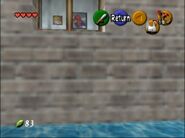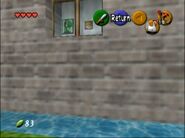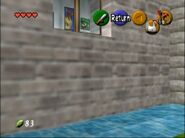|
The Legend of Zelda: Ocarina of Time is a Nintendo 64 classic that was released on November 21 of 1998 in Japan, and soon after in other territories. The game has been ported twice to the GameCube, the Wii's Virtual Console, the Chinese exclusive iQue Player, and remade for the Nintendo 3DS. The game is the first 3D title in the series and the first of two for the Nintendo 64. The game incorporates a unique locking on system that has been copied a variety of times in subsequent video games - both in and out of the series. To this day, the game has been both a critical and financial success, widely considered to be the greatest video game ever created. It is currently the highest rated video game of all time and has sold a total of over seven million copies on the Nintendo 64 alone.
Gameplay
Avoiding the traditional bird's eye view, Ocarina of Time was a full-fledged 3D title that included a huge world. Players would gradually become more experienced after obtaining new items and collecting more health, a formula that has been in the series since the very beginning. Staying true to the series, puzzle elements were back and arguably more challenging than ever.
In Ocarina of Time, the player controls the protagonist Link. Link has a variety of moves, more so than any other installment in the series. This is partly due to the newly implemented 3D engine that was copied from Super Mario 64. It incorporated an interesting lock on system that can be performed by pressing the Z button. After pressing this button, Link will subsequently lock onto an enemy, object or character and will then be able to perform various actions depending on what it is. Locking on is crucial in order to complete the game - otherwise it would be very demanding and would be a task that only the devoted fans would attempt.
Link's most basic weapon is his sword, of which he can have three different types, each one being more powerful than the previous. The first, the Kokiri Sword, is obtained early on in the game, while the Master Sword will come in your possession when you turn into an adult. The Goron's Sword can only be held when the other arm is unoccupied, though is well worth it when taking on bosses and mid bosses. You'll also have a shield a majority of time, which, like the sword, there are three of, each one being more powerful or performing an ability that the previous didn't have. The final shield, the Mirror Shield, can reflect light and magic, while the Hylian Shield will not burn as the wooden one will.
Other than these two prominent items, you'll have a multitude of other weapons as well. These weapons can be assigned to the bottom, left and right c-stick buttons, and are usually found within the game's dungeons. Other than weapons, other items will also be assigned to these buttons, such as your ocarina, bottles, magic and quest items. Weapons that you aim, such as the bow and arrow and the slingshot, and also lock onto enemies using the tactic mentioned in the first paragraph.
The game's large world is separated via Hyrule Field. There are many different locations that are found on the outskirts, with the capital being Hyrule Castle Town, which can basically be considered the hub of the game, though you won't travel there until you complete the first dungeon. Each location has its own theme, music, challenges and species. The names of the locations will usually reflect which race lives there. For example, Gorons exclusively live in Goron City while the same can be said about the Zora for Zora's Domain and the Gerudo in Gerudo Valley. In all there are six main species, with only one which has very few left (the Sheikah).
New to the series is Epona, a horse which can be accessed when Link turns into an adult. With the horse, Link can traverse the vast world more quickly than before and even battle while atop his loyal steed. In order to call Epona, the player will have to play Epona's song. Epona is required to get to Gerudo Valley, which was blocked off after the bridge collapsed. The bridge can eventually be rebuilt however with the help of the Carpenters, who you'll have to rescue.
The Ocarina is the primary item. By playing songs on the Ocarina (the notes can be performed using the four c-stick buttons and the a button), a multitude of different events will take place depending on which one you played. In all there are 12 different songs, with half of them transporting you to a particular location (all of which you learned from Sheik) and the others doing other tasks. There is a bonus song called Scarecrows Song that the player will find on his own. The Ocarina and its songs became so popular among fans that it was implemented into the game's successor The Legend of Zelda: Majora's Mask. Early on in the game you'll have the Fairy Ocarina, which Saria gave you, though after a bit Zelda will give you the Ocarina of Time, which is needed in order to gain access to the Temple of Time's Sacred Realm.
Pieces of Heart are scattered throughout Hyrule. Finding four of them will add one health bar. In all the player can have a total of 20 hearts, though as the game progresses the enemies' attacks will become more potent, with some bosses' delivering attacks that'll deplete up to four hearts at a time.
Dungeons
Found within the primary locations are dungeons and temples. In all there are ten dungeons which must be conquered in order to complete the game. The first three will take place before Link claims the Master Sword, while the others he'll take on as an adult (or a mixture of the two). Dungeons are the most challenging locations of the game, and will require the best of your abilities. The Water Temple is often lauded as one of the most challenging portions of any video game ever released. In each dungeon there is a mid boss and a main boss. Defeating a mid boss will usually reward the player with a new weapon, while defeating the main boss will complete the dungeon and reward you with a Heart.
The following are a list of dungeons in Ocarina of Time.
- Inside the Deku Tree - The first dungeon in the game will have you traveling through the Great Deku Tree in an attempt to break the curse bestowed upon him by Ganondorf. After completing the dungeon, you'll come in possession of the first Spiritual Stone.
- Dodongo's Cavern - This cavern was once a great source of food for the Gorons, though recently was infested by Dodongo. Your goal is to dispatch the species from the dungeon. Doing so will reward you with the second Spiritual Stone.
- Inside Jabu-Jabu's Belly - This stage takes place inside the belly of Jabu-Jabu, whom the Zora look upon as a deity. After saving Princess Ruto within him, you'll be rewarded with the last Spiritual Stone, and will thus be able to travel into the future.
- Forest Temple - The first dungeon you'll take on as an adult. It features the famous twisted hallway. Completing this dungeon will awaken the sage Saria.
- Fire Temple - In this temple you'll have to rescue all of the Gorons who were captured by Ganondorf and were planned to be fed to Volvagia as a threat to the other species who didn't comply with his requests. Link managed to save them all and awaken the second sage Darunia.
- Water Temple - Oftentimes considered the most challenging temple in the game, the Water Temple had you solving a variety of puzzles and ultimately awakening the third sage, Ruto, in the end of the game.
- Shadow Temple - A temple that had you going through a labyrinth of hidden areas. In the end you'd awaken the next sage, Impa.
- Spirit Temple - In this temple you have to traverse the area as both a child and an adult in that order. Completing the temple would awaken the sixth sage, Nabooru.
- Ganon's Castle - The final temple, this castle features a variety of different themed locations, plenty of mid bosses and eventually Ganondorf himself.
Plot
Spoiler warning: The following information contains spoilers. Please read at your own risk.
In the game's beginning, Navi the fairy will soar through Kokiri Forest until she arrives to her destination - Link's house. She was ordered by the Great Deku Tree to bring Link to him, though before doing so Link was required to come in possession of a sword and a shield, both of which can be found in the village. Once the summoned subject arrives, the Great Deku Tree will explain how he was cursed by the antagonist Ganondorf. Link tries to his heart's content to save the tree by entering inside of him and dispatching the source of the curse bestowed upon him - Gohma, though the tree was inevitably going to perish because of it, and thus did so before telling Link his journey in which he would have to partake in order to save the world. His parting words were to tell Link to head straight to Hyrule Castle, and before dying gives him a spiritual stone - one of three.
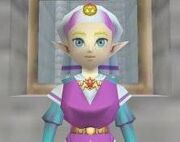
Zelda in Hyrule.
After traveling through Hyrule Field and subsequently entering Hyrule Castle Town, he heads towards the castle and passes by the guards that are making sure there are no trespassers. Upon entering the castle he meets Princess Zelda, who like Link is nothing but a child. She tells Link of her foretelling dream of a dark lord upon horseback - the one who cursed the Great Deku Tree to his death, and tells Link of the impending doom upon their land that she witnessed in her dream. She trusts that none will believe her, and requests that Link does and find the remaining two stones that are in the possession of the Gorons and the Zora. Ganondorf attempted to claim the one the Great Deku Tree, and cursed him once the tree wouldn't give in. If Ganondorf did have all three of the stones, then he would be given access to the Sacred Realm, within it the Triforce, a relic which would give him powers beyond what is normal. By finding the three stones before the evil king, Link would be able to acquire the Triforce before he would.
First Link would head towards Goron City and latterly Zora's Domain in order to find the two remaining stones. In both of these locations, Link was required to right what was wronged by Ganondorf - in the Goron's case it was to thwart the Dodongos within the Dodongo Cavern and to clear the boulder that was blocking it in order that the Gorons could enter and reap its benefits, which consisted of the species' primary source of food. For the Zora he was required to enter Jabu Jabu's belly and save Princess Ruto, after which she'll give him the Zora's Sapphire (the last Spiritual Stone) as a token of her appreciation.
Upon returning to Hyrule Castle to explain to Zelda of his success with finding the stones, Link witnessed in horror as Princess Zelda with Impa fled the castle after Ganondorf attacked it. Ganondorf's goal was to come in possession of the Ocarina of Time, of which he would also need in order to enter the Sacred Realm. After passing by Link, Zelda heaved the Ocarina into the moat by the castle without Ganondorf noticing. Link stayed his guard in order to prevent Ganondorf from going any further, though the dark lord used his magic to cast him aside and rode on without considering the potential threat the boy would become in the future. Afterwards Link entered the moat and recovered the ocarina.
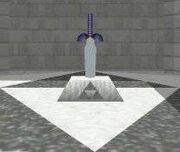
The Master Sword in the pedestal.
Directly after getting the ocarina, he headed straight towards the Temple of Time and subsequently entered the Sacred Realm using the three stones and the ocarina. He thrust the Master Sword from its pedestal. The Master Sword is a recurring weapon that is required to thwart evil's bane, i.e. Ganondorf. However, Link did not expect the next event - the sword sealed Link away in the realm for seven years until he would be old enough to wield the sword efficiently and defeat the enemy. However, before it sealed him, Ganondorf entered the realm which was opened by the hero of time with Link inside and snatched the Triforce for himself. Link could do nothing but watch in horror. Link would not know what would occur next until seven years have past.
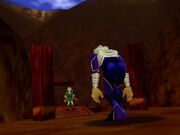
Link encountering Sheik.
Link would learn after the seven years that the Triforce had separated into three parts when Ganondorf took it for himself. The triforce represents courage, wisdom and power. If the wielder is not balanced with all three, then it will separate, which happened with Ganondorf, who was filled with more power than courage or wisdom. While the three portions separated, only the Triforce of Power remained with him. The other two would later be revealed to have been within Link (courage) and princess Zelda (wisdom). He would need to have everyone together in order to wield its true power. Meanwhile, a prophecy foretold of six sages who dwelt within six separate temples that could be awakened to counter the one who had such power. Rauru, one of the sages, was within the Temple of Time. He instructed Link to search for the others, which he would do so successfully. The others included many characters Link knew from the past, including Saria, Darunia, Ruto, Impa and Nabooru. While searching out the sages, Link would often be greeted by a mysterious character known as Sheik, who would teach Link a variety of songs for his Ocarina. After fulfilling his destiny, Link found that there was a seventh sage - Sheik. After conversing with the character, Sheik revealed her true form - Princess Zelda. She had disguised herself as a Sheikah in order not to be caught by Ganondorf, who was eagerly seeking her. After revealing herself, Ganondorf quickly found her location and kidnapped her, bringing her into his castle which had replaced Hyrule Castle. Link sought after her, though found the castle hovering in mid air. The six sages bound their powers together and created a pathway, which gave Link access.
Once inside, he was forced to destroy six barriers which incorporated the themes of previous dungeons in the game. After doing so using the newly acquired Light Arrow, Link took on Ganondorf himself. After defeating him without the help of Navi, he rescued Zelda and they made their way outside the crumbling tower. Once outside, Ganondorf transformed into a terrifying beast known as Ganon, who is known as a ruthless boar like creature. Link was required to finish him off by attacking him with the master sword and in the end thrusting his blade into the beast, thus ending his long adventure. The sages cast the beast into darkness, though it would inevitably make its return to try and take claim of the Triforce once more, though this story had ended. Link was sent back to the past, and the citizens of Hyrule rejoiced as the sages (excluding Rauru and Zelda, the latter of which was sent to rule over Hyrule) looked over them on Death Mountain. Link's journey had ended, and his descendants would once more wield the sword to defeat evil's bane as he had done.
Spoiler warning: Spoilers end here.
Setting
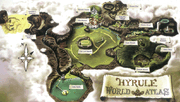
The official map of OoT's Hyrule.
The game takes place in Hyrule, the kingdom in which most of the games take place. Many dungeons and cities surround Hyrule field, and the monarchical castle where the adjudicators live is found to the North.
In all there are eight prominent areas in Hyrule, which include the Goron infested Death Mountain, Gerudo Valley, home of the Gerudo, the capital Hyrule Castle, the overworld Hyrule Field, the small town known as Kakariko Village, the large lake known as Lake Hylia, the Lost Woods, which takes place in the beginning of the game, and Zora's River, where the multitude of Zoras live.
Characters
There are various prominent characters in The Legend of Zelda: Ocarina of Time. The following are the Triforce bearers and the sages. For a full list of characters, go to the link above.
Triforce bearers
- Link - The name of this character can be altered to your liking, though the default name is simply Link, as it is in every Zelda installment. He's the Hero of Time and the wielder of the Triforce of Courage. In the game, he'll be a child in the beginning, though about mid-way he'll go seven years into the future and will be an adult. He's the main character and the only one who is capable of thwarting Ganondorf's malevolent plans.
- Ganondorf - The antagonist of the game and the sole male member of the Gerudo tribe. In the game, his goal is to seek and take the Triforce, thus giving him full control over the land of Hyrule. Link, with the aid of multiple other characters, must stop him. He wields the Triforce of Power.
- Princess Zelda/Sheik - The princess of Hyrule. In the beginning of the game, she uses her magical abilities to foresee the future. She also uses her abilities to disguise herself as a Sheikah named Sheik. She is also one of the magical sages. She wields the Triforce of Wisdom.
The Sages
- Rauru - The first sage that Link will find after the seven years has past. he commands Link to find the others.
- Saria - Link's childhood friend, who is always playing the Ocarina. She's the Sage of the Forest.
- Darunia - The Tribe Leader of the Gorons. He Awakens as the Sage of Fire.
- Ruto - The Young princess of the Zoras. She becomes the Sage of Water.
- Impa - A member of the Sheikah and Princess Zelda's protector. She is known as the Sage of Shadow.
- Nabooru - The Second in Command of the Gerudo. She betrays Ganondorf when she becomes the Sage of Spirit.
- Note! - Princess Zelda is also a sage, though because she is also the bearer of the Triforce of Wisdom she is listed above.
Bosses
- Parasitic Armored Arachnid: Gohma- The first boss Link encounters. It is found inside the Deku Tree.
- Infernal Dinosaur: King Dodongo- The second boss. Found inside Dodongo's cave on Death Mountain.
- Bio-Electric Anemone: Barinade- The third Boss in Ocarina of Time. He resides in Jabu-Jabu's Belly.
- Evil Spirit from Beyond: Phantom Ganon- A Boss similar to Ganon. Found in the Forest Temple
- Subterranean Lava Dragon: Volvagia- Found in the temple of fire in Death Mountain Crater.
- Giant Aquatic Amoeba: Morpha- Resides in the Water Temple at the bottom of lake Hylia.
- Phantom Shadow Beast: Bongo Bongo- Found in the Shadow temple in Kakariko Village.
- Sorceress Sisters: Twinrova - Fought in the temple of Spiritsin the Desert Colosus.
- Great King of Evil: Ganondorf - The main antagonist fought in Hyrule Castle.
- Ganon - The Final Boss. A more powerful version of Ganondorf.
Development
Ocarina of Time was initially shown during SpaceWorld of 1995. During its development period, Ocarina of Time was being created alongside Super Mario 64 by the same company. When it was first shown, it featured drastically different graphics that weren't nearly as appealing to the eye as they are now. It was originally planned to be a video game that made use of the 64 Disk Drive add on and would make use of the console's internal clock, internet connection and even image editing. According to some the game they had planned was not even possible on the console. Producer Shigeru Miyamoto has stated that they wanted the entire world in the game to not only be effected by what the player did, though stay that way throughout the entire game, whether it be footprints, broken bottles and cracked trees. Because of the failure of a similar add-on for the Super Nintendo Entertainment System, they ditched the project and decided to make Zelda 64 exclusively for the console.
Something else that also changed during development was Miyamoto's idea of making the game a first person video game in a similar vein to Goldeneye 007, though it was almost mutually agreed among the rest of the team that this wasn't a good idea, thus changing it into a 3rd person perspective. A first person view was intended to help give the players a better look at the environment around them and be able to better observe the enemies. The camera in the game reflects Miyamoto's idea of allowing the player to have a fantastic look at the world around them - it's heavily controlled by AI rather than the player controlling it as they did in Super Mario 64.
Version differences
In all, there were three different versions of Ocarina of Time including 1.0, 1.1, and 1.2. The differences were minor, though they were there. For one, the cartridges were different colors, with version 1.0 being either gold or gray, and 1.1 and 1.2 being just gray. The blood of Ganondorf was changed from red to green and minor glitches were fixed. The Fire Temple's theme that resembled an Arabic chant as well as symbols resembling the Islamic "star and crescent" symbol on the Mirror Shield were taken out, which was rumored to be due to offense taken by Muslim gamers, but this reasoning was unapproved by Gametrailers.com in an episode of Pop-Fiction.[1]
Commercial
The commercial for Ocarina of Time is actually pretty impressive for a Nintendo developed ad, featuring exclusive music, plenty of action packed scenes and dialogue as follows -
A dark time is approaching
Willst thou run?
Or fly?
Willst thou sink?
Or swim?
Willst thou finish?
Or die trying?
And in the end.
Willst thou soar?
Or willst thou suck?
Have ye what it takes?
Legacy
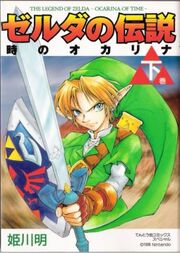
The game inspired the release of a manga based on it.
The Legend of Zelda: Ocarina of Time was the first of many 3D Zelda video games, and thus inspired the creation of The Legend of Zelda: Majora's Mask, The Legend of Zelda: The Wind Waker, and The Legend of Zelda: Twilight Princess. Many other titles in the genre have unarguably been influenced by the title as well.
Characters from the video game have been present in other titles in the series and outside of it as well. In Super Smash Bros. for the Nintendo 64, Link and Hyrule Castle (a character and stage, respectively) are both based around their incarnations in The Legend of Zelda: Ocarina of Time. In Super Smash Bros. Melee for the GameCube, both Link, Zelda and Ganondorf are all based around their appearance in the classic, while the same can be said about the Temple stage. In the beginning cinematic for the game, scenes from Ocarina of Time can be seen in the background when Link is posing.
Contributions
The game is known for its major contributions to the series.
- It is the first 3-dimensional Zelda game, introducing far better detail for characters, locations, and objects.
- It introduces a 3rd-person perspective in favor of the traditional top-down perspective (although some locations require a top-down view).
- Using the C buttons for up to three secondary items
- Autojump for various pits and ledges (although this requires timing and accuracy)
- The ability to lift items without the Power Glove
- The ability to break clay pots with the sword
- Additionally, items only appear when the pots are broken instead of when they are lifted.
- More complex camera angles (although they sometimes pose frustrating challenges)
- The introduction of the barrel roll
- The use of real-time day/night transitions (although far shorter than Earth time)
- The acquisition of important items has been significantly lengthened, with no more than one major item per dungeon. In the original game, the Boomerang, Fairy Bow, and bombs could all be acquired in the first dungeon.
Manga
The game inspired the release of merchandise based on it, including an Ocarina, various models and plush toys, and even a manga which has just recently been released in North America. The Manga was separated into two books called the child saga and the adult saga. Some things were altered from the video game - some even very dramatic. It's assumed that the Manga isn't canon because of the things that were changed - such as Volvagia, one of the game's major bosses, was a friend of Link's to some extent when he was a child. Nevertheless the beast was beheaded by Link after the dragon went insane. Some things, however, are better explained in the Manga then they are in the game.
References to other video games
Plenty of references or cameos have appeared in The Legend of Zelda: Ocarina of Time that clearly were meant to represent multiple different games or characters from the Nintendo universe. In Hyrule Castle where you talk to a young Princess Zelda, you can look through the windows in the courtyard and observe pictures of Mario, Yoshi, Princess Peach, Bowser and Luigi.[2]
Another notable Mario series reference can be seen in Malon's farm, where Talon and Ingo both resemble Mario and Luigi (respectively). Also, all of their bracelets that they possess have emblems of Bowser's face on them.
Hackers have found an enemy that wasn't included in the final installment, and one that was surprising to all fans. When hacked an actual Arwing from the Star Fox series could be seen in the game, it was a leftover from beta testing and was used to test flying enemies before Keese had been added to the game. It would shoot at Link, quickly draining his health. The sounds and models of the arwing were all taken from Star Fox 64, which was released just a bit before Ocarina of Time was.
Re-releases and remakes
A special Master Quest remake was released on the GameCube. The Master Quest is harder than the original game, akin to the Second Quest in the original The Legend of Zelda.
Ocarina of Time was released on the Virtual Console download service. However, the vibration capabilities are not included with the N64 downloads. The vibration was retained on the GameCube ports, however. The Virtual Console version was otherwise identical to the GameCube port, with all Islamic references removed.
Nintendo has released a remake of The Legend of Zelda: Ocarina of Time on the Nintendo 3DS titled The Legend of Zelda: Ocarina of Time 3D. The game has enhanced graphics, music, and controls. Many new features are also included.
Reception
Ocarina of Time is the best-selling Zelda game of all time, selling 7.6 million copies worldwide. It is also the 4th bestselling N64 game.
References
<references>
External links
- The Legend of Zelda: Ocarina of Time at Nintendo.com
- The Legend of Zelda: Ocarina of Time at Virtual Console Reviews
- ↑ http://www.gametrailers.com/video/episode-9-pop-fiction/710815
- ↑ The images showing off the characters were artwork released for particular games including Super Mario 64, Yoshi's Story, and others.

